by The History Chicks | Mar 8, 2013 | Biography Episode, Episode, News, Podcasts, Shownotes
Once a season we step away from factual subjects and focus on a fictional one. This season we traveled to the land of Oz and took a look around.
“But Chicks,” you say,”a Wizard is a man.”
To that we respond: Thank you for pointing this out. Yes, the Wizard is a man, and L. Frank Baum is a man…but Oz is full of women! Dorothy! Glinda! Ozma! Oz is a land of female rulers and strong charactered inhabitants- how could we not talk about it? (Besides, we like fantasy, okay? And there are several points in the Six Degrees of History Chicks Separation game with this subject. Just trust us.)

W.W. Denslow illustration from The Wizard of Oz by L. Frank Baum
We’re sure several images popped into your head when you saw the title, and we will cover most of them in this episode…except three: Judy Garland, Billie Burke and Margaret Hamilton. We decided to have a separate conversation about the lives of the three female stars of the 1939 movie . That chat will be posted as a companion minicast .
In 1900 L. Frank Baum introduced the world to the imaginary land of Oz. It wasn’t the first children’s book that he had written-but it would become a series that he would work on for the rest of his life that is full of characters, settings and storylines that are still being explored today.
Born in 1856 in Chittenango, New York, Lyman Frank Baum was the son of a barrel maker and occupational experimenter who struck it rich in the oil business- Benjamin Baum and his wife, Cynthia Stanton Baum. Frank was a sick child with a weak heart but a big imagination. He also had the gift of very indulgent parents.
Aside from a short stint at Peekskill Military Academy (where there was, literally, a yellow brick road), Frank was educated at home by tutors and parents who helped him peruse any interests he had. When he took an interest in the printing process, his parents bought him a home printing press. Later when he took an interest in acting, they got him a theater.

Franks brief experience in a military school…not exactly his thing
Once grown, he began touring with an acting company until he met Maud Gage- daughter of Elizabeth Cady Stanton’s co-author Matilda Jocelyn Gage. Love. Within a year they were married, and when she became pregnant with the first of four sons, the acting life ended and Frank the dreamer needed to become Frank the supporter.
He did not find success as a chicken breeder, store owner, newspaper man, or traveling salesman. One day he wrote out the Mother Goose rhymes that he had been sharing with his sons and they became his first book- Mother Goose in Prose. His second was a spin-off of that one, Father Goose: His Book.
Shortly after these two successes, he wrote down the stories he had been telling his sons and the neighborhood kids about a little girl named Dorothy in a magical land named Oz. With clever illustrations by W.W. Denslow, The Wizard of Oz was a hit.
Frank brought the story to the theater with a stage version ( although the adult cast wasn’t exactly what he had in mind when he wrote the story), and this also was a success. While he had no interest in writing another Oz book, he did have an interest in putting food on the table for his family. Frank Baum was an imaginative writer, but a businessman he was not and he would earn and lose his wealth many times over the years. Within four years of the first Oz book he was publishing a second. He would write 13 sequels to the original story (including our favorite- Ozma of Oz).
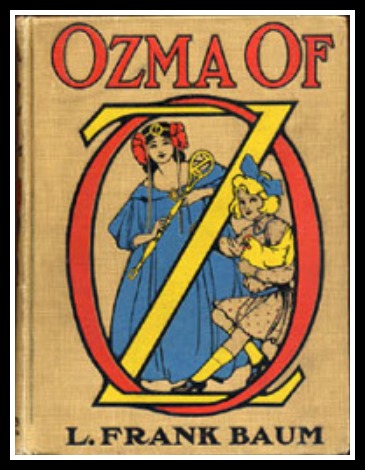
Shh, don’t tell the others, but this is our favorite
But that’s not all! Frank wrote several books and plays under pseudonyms and several of those were women’s names- the most successful being a series for teenage girls, Aunt Jane’s Nieces, under the pen name, Edyth Van Dyne.

L. Frank Baum circa 1911
Frank Baum died on May 6th, 1919 at the age of 92. His last book, Glinda of Oz, was published posthumously a year later.
But the Oz books couldn’t end! Not only was the world enthralled with the story, it was making some serious coin for its publishers. After Frank’s death another 36 books would be written by a variety of authors making up what is considered the official 40 book Oz series.
About 38 years down the yellow brick road technology caught up with the stories. After Walt Disney scored big time with Snow White, movie makers were looking for the next big fairy tale and MGM landed Oz. We geek out about the making of this iconic movie for quite a while during the podcast. We chat about trivia as well as the differences between the movie and the beloved books (Like the shoes: Dorothy originally was gifted a pair of silver shoes, but red showed up so much nicer in Technicolor.)
2.6 million dollars, five directors, scores of writers, two Tin Man actors, and a shooting schedule that stretched from 6 weeks to 23 The Wizard of Oz finally opened…
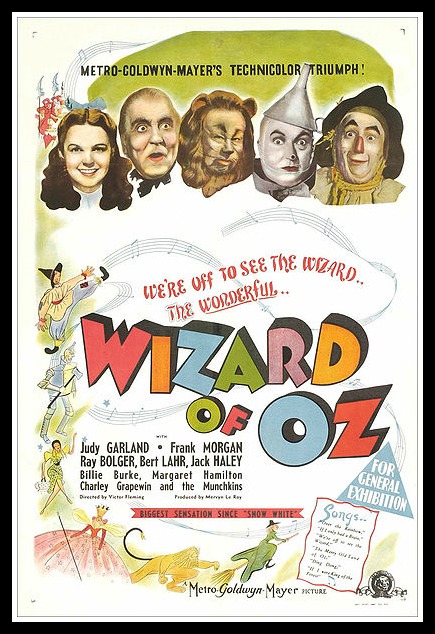
Not the first technicolor movie by a long shot and didn’t follow the books exactly (and we cover those differences in the podcast), 1939 MGM movie poster
…and didn’t quite do as well at the box-office as you would have expected. While this film lasts on mostly due to annual televised showings beginning in the mid 1950’s- the movie wasn’t a flop by any standard, but it did originally fail to be a financial success. The movie did win two Academy Awards as well as a special award for 16 year-old Judy Garland.
TIME TRAVEL WITH THE HISTORY CHICKS
So you really don’t want to read all the books in the Oz series, we get that- 40 is a lot of books. Here is a really fun shortcut to the plots and characters of each book as well as all the original cover art to them. Maybe after you read these reviews you will give in and get one of the books. And another. And another. Hey, fantasy series are all the rage these days- there is a reason and Oz started them all. Mari Ness on TOR.COM
Other than the books in the Oz series, we didn’t have a lot of recommendations for this episode. We think that the Annotated Wizard of Oz was pretty terrific, as well as the Wicked Years series by Gregory McGuire and Was by Geoff Ryman (very dark, but very good).

Annotated Wizard of Oz edited by Michael Patrick Hearn

Was by, Geoff Ryman
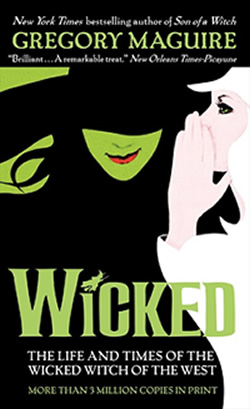
The Wicked Series by Gregory Maguire (also available on Audible.com and you can get a free book just by clicking the link to the far right, no, up higher…just sayin’)
And as far as movies go, get thee to the library and borrow the 3 -disc Collector’s Edition of the 1939 movie! So many special features you will be all Oz’d up in no time!
1978 brought a very interesting version of movie (it had previously been an Tony award winning Broadway play) The Wiz starring Diana Ross and Michael Jackson. Make your own judgement if it’s destined for Cult Movie Classic status or not.

1978 musical The Wiz
You can catch Tin Man, the Sci-Fi channel mini-series starring Zooey Deschenel, streaming on Netflix and decide if you think it’s good (and forgive Zooey for this one) like Susan, or if you can’t get past the first episode like Beckett.

Classic Oz touches sprinkled through story in semi Once Upon a Time style
Join in the serious business at the International Wizard of Oz Clubs, or join some chat with the Royal Historians and all at The Royal Website of Oz.
The Studio 360 podcast episode “American Icons: The Wizard of Oz” can be found here, or on ITunes: Studio 360
Want to read the rest of the Evil Overlord list? Find it here: The Evil Overlord List
Investigate your name’s popularity over time at The Baby Name Wizard (warning! It’s addictive!): Baby Name Wizard
Finally, there are a pair of the Ruby Slippers Judy Garland wore in the movie at the Smithsonian, but if you are looking for an Oz museum as you cross Kansas, here is one in Wamego, Kansas ( just east of Manhattan). We have not been, but if you have let us know how it is in the comments!
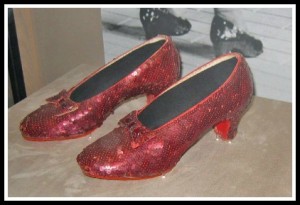
On display in Washington, one pair of the movie ruby slippers
As always, our music comes courtesy of Music Alley. Visit them at music.mevio.com
(closing song – If I Only Had a Brain by Elijah Tucker)
by The History Chicks | Feb 13, 2013 | Biography Episode, Episode, Podcasts, Shownotes
Before there were suffragists to march and fight for the vote, there was Elizabeth Cady Stanton. Before she teamed up with another superhero for women’s rights, Elizabeth was a daughter, a sister, a wife, and a mother. Then, one warm summer day in 1848 in Seneca Falls, New York she stood up, gave her first public speech and helped to start a movement.
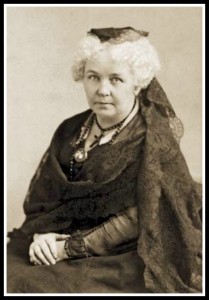
Elizabeth Cady was born in November 12, 1815 in Johnstown, NY. She was the eighth of eleven children of Daniel- a lawyer and judge- and Margaret Cady. All but one of their sons died in infancy and Daniel’s hope rested on his surviving son, Eleazar. That hope was crushed when he, too died at the age of 20. Elizabeth, then 11, couldn’t understand why she couldn’t fulfill the hopes of her father who said to her, “I wish you were a boy.”
She tried- she rode horseback and tried to do “boy” activites. She studied hard and excelled academically but there was one thing that she couldn’t control and it was the one thing that held her back: her gender. Once she exhausted the educational options that she had, Elizabeth became involved in the Abolitionist and Temperance movements and began down a pretty traditional path when she married Henry B. Stanton.
Well, sort of traditional- except that she and Henry, a Reformer working to abolish slavery, took the word, “obey” out of the traditional vows, and their first voyage after marriage was to London for a World Anti-Slavery Convention. How’s that for a honeymoon? Of course, there is a lot more to the story (A LOT- we tell you this every time, you have to listen to the podcast to get all the juicy bits)- but while in London Elizabeth’s eyes were opened to several things. The one that impacts this tale, is the way that women were treated- even delegates at the convention who were female were not allowed to participate in any more than an observational role. She also met some rock stars in the human rights arena but during her time not participating in the proceedings, she and Lucretia Mott- a Quaker preacher who was very active in the anti-slavery movement- formed a friendship that would have a significant impact on Elizabeth’s life in a few years.
But first Elizabeth lived the married life of the wife of a lawyer in Boston. She had three children in short order and set up housekeeping in the city. She enjoyed her life a great deal- hello!- she was hobnobbing with the likes of Nathaniel Hawthorne and Ralph Waldo Emerson. But all good things must end and the family moved to Seneca Falls, NY (upstate, to the left- about halfway between Albany and Buffalo). In this new phase of her life she wasn’t as content as she had been in the city. She kept having babies (seven in total), but lacked the staff , support and outside interests that she had in Boston. Henry traveled a great deal as an anti-slavery lawyer and politician- and Elizabeth got caught up in the drudgery of small town life.

Elizabeth and two of her boys around the time of the First Women’s Rights Convention
One day, her old friend Lucretia Mott came to town and Elizabeth was invited for tea with her. Shortly after this the women present had created, advertised and were holding the First Women’s Rights Convention in Seneca Falls (if this story is new to you, THIS is one of the historical turning points that President Obama was referencing in his 2013 inaugural speech). In front of an audience of about 300 people who had packed into the Wesleyan Chapel Elizabeth wrote and delivered her first public speech ever, the Declaration of Sentiments based on Thomas Jefferson’s Declaration of Independence. The points outlined in the speech were designed to create laws that protected women and put women on equal footing legally with men. And the biggie? The right to vote.
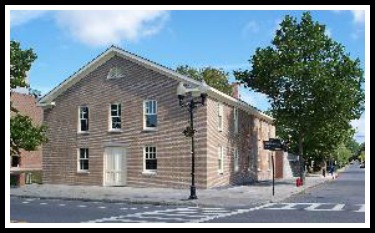
Now part of the Women’s Rights National Park, the Wesleyan Chapel held the first Convention. (photo courtesy nps)
From where we are sitting suffrage for women seems like a no-brainer, but in this time it was fairly scandalous. Women at the time were not considered intelligent enough to sit on a jury, let alone own property, have a legal say in the welfare of their own children, or help to decide the government of their own country. 100 people signed the Declaration that day, mostly women but some men- vowing to do what they could to create change. Elizabeth, however, was torn. She was becoming rather famous for her speech but she felt strong devotion and loyalty to her family. How could she help the cause when her primary responsibilities required her to stay home?
Enter one Susan B. Anthony. The two met one day and not only was a friendship formed- but a partnership. Elizabeth could write the words, and Susan- who was single and not tied to family obligations- could travel to deliver them. Elizabeth would later say, “I forged the thunderbolt, she fired it.”
For the next 50 years the two would work together on the cause of women’s rights.
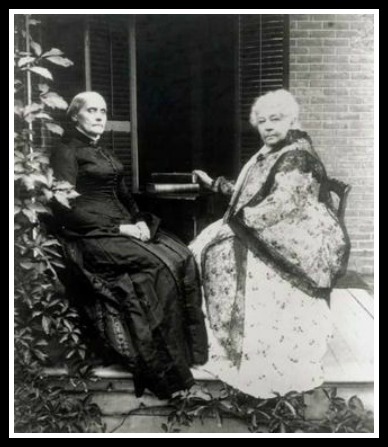
Susan B. Anthony and Elizabeth later in life, they even look like the opposites that they were, don’t they?
It wasn’t easy, and they would often disagree. For instance, at one point Susan thought that the sole mission should be to get women the vote, while Elizabeth thought more broadly to religious and legal freedoms. But work together they did. For the most part, Susan did the leg work and Elizabeth did the brain work. But often Susan would travel to Elizabeth’s home and help out with domestic chores so that new speeches could be written.

The mahogany table that the women would work at at Elizabeth’s house and where Elizabeth wrote the Declaration. It later was at her funeral.
During that time they put in years of hard work, devotion, standing up for what they thought was right all with a goal of women’s suffrage in their minds and actions. It’s a long story and we go into some detail during the podcast, but it is filled with success and failure; determination and drive; support and alienation from those who they encountered; work for not only women’s suffrage but temperance and abolition, too. Elizabeth did it all while raising her family without much help from her traveling husband.
As the two women slowed down, just a bit- they got together to document the tale of the work done thus far in a book that would take years to write- The History of Women’s Sufferage. Susan managed to vote in an election, although she was famously arrested, charged and fined $100 for her attempt. Elizabeth spoke throughout Europe and caused quite a ruckus when she re-wrote the Bible into The Women’s Bible offering counter-discussions for time honored interpretation of scripture from Genesis to Revelation. She also wrote her memoirs, Eighty Years and More. Together they wrote a document and got it into the rights hands to be presented to Congress. This little document, very short, but very important, would be presented in every session for the next 45 years.
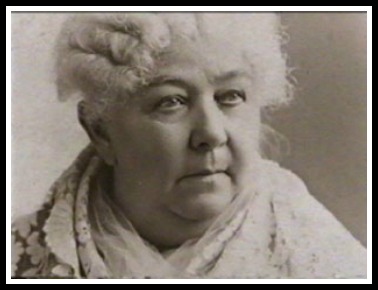
On October 26,1902, Elizabeth was 86 years old and living in New York City with her daughter. She was losing her eyesight and in constant need of physical assistance. She asked for assistance to stand, took in the view for several minutes, then was instructed by her family to sit she lay down and took a nap. That day she died in her sleep.
Susan would carry on the fight for the next four years, dying in 1906.
In 1920 the document that they had prepared was finally ratified and became the 19th Amendment to the Constitution granting women the right to vote.
TIME TRAVEL WITH THE HISTORY CHICKS
Companion podcast! Beckett reads the Declaration of Sentiments in a companion podcast. CLICK HERE .
Museum! If you happen to be near Seneca Falls, NY, you have to (have to…must, really!) visit the Women’s Rights National Historic Park. There are four properties including Elizabeth’s house and the Wesleyan Chapel where the first Women’s Rights Convention was held.
If you are interested in reading some of the works of Elizabeth Cady Stanton, try The Papers Project or the National Archives Teaching with Documents site. A History of Women’s Suffrage and The Women’s Bible are in the public domain and can be read through Project Gutenberg.
One of the organizations that Elizabeth helped to found and was the first president, The National American Women’s Suffrage Association morphed after the 19th Amendment into the League of Women Voters and is still an active organization today.
THE 19th Amendment!
Movies- we recommend this one Ken Burn’s documentary that is streaming on Amazon (Or get it from your library), Not For Ourselves Alone: The Story of Elizabeth Cady Stanton and Susan B. Anthony.
Books!
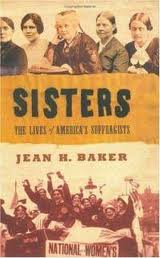
Sisters: The lives of America’s Suffragists by Jean H. Baker
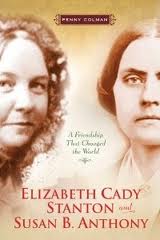
Elizabeth Cady Stanton and Susan B. Anthony: A Friendship That Changed The World by Penny Colman
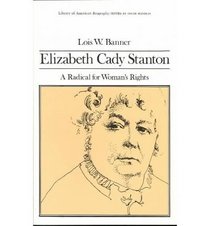
Elizabeth Cady Stanton: A Radical for Women’s Rights by Elizabeth Griffith

Elizabeth Cady Stanton:An American Life by Lori D. Ginzberg
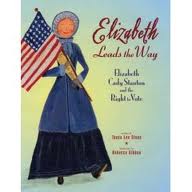
Kid’s book Fave: Elizabeth Leads the Way by Tanya Lee Stone illustrated by Rebecca Gibbon
And finally, Elizabeth is in this book- but so are many others, but it’s just a great read (and if you have anyone else attributed to this quote than the author of this book on your Pinterest boards- go change it now!)
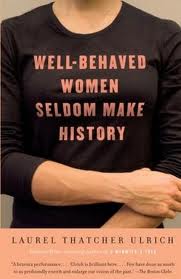
Well-Behaved Women Seldom Make History by Laurel Thatcher Ulrich
Susan here. I stand corrected. The dance that my kids learn in physical education not history class in middle school is the Cotton Eyed Joe. Not necessarily a Missouri dance but one that originated in the south prior to the Civil War with probable slave origins. I still think it’s wonderful that a folk dance is taught, and remembered in this day and age. Take that Cupid Shuffle and we’ll see where you are in 150+ years.
As always music comes courtesy of Music Alley. Visit them at music.mevio.com
by The History Chicks | Jan 21, 2013 | Episode, Podcasts
In this episode we continue our chat about the many acts in the life of Josephine Baker. When we went to intermission, Ms Baker was touring the world as an entertainment superstar with the help of her manager/fake husband/fake Count, Pepito Abatino. The one place that she had left to embrace her was her native country, the good ol’ US of A. When the house lights went up we were biting our nails! Would her homeland love and appreciate her as much as the people of other continents? Could Josephine go home?

Act Three
(It’s 1934 and Josephine is taking the stage at the Ziegfield Follies in New York expecting a warm and loving response)
Crickets chirp.
Josephine didn’t have to get far onto US soil before she faced racial prejudice. As a ‘married” couple she and Pepito could share a hotel room, but not an entry door into the hotel. Her performances were not met with a warm reception for a variety of reasons: she danced with white male partners, her level of undress made audiences uncomfortable, and the songs that she was required to sing were not suitable for her voice. Her part in the show was your basic hot mess. Josephine blamed Pepito and sent him away, back to France ending their ten year relationship…and quite possibly his life. He was hospitalized and died of unknown causes a few weeks later. Stomach cancer or a broken heart?
Josephine got out of her contract and the US as quickly as possible. Shortly afterward she married Jean Lion, a wealthy French businessman. With this marriage she legally became a French citizen and had hopes of becoming a mother. Jean apparently had high hopes of her becoming his most fabulous accessory, a trophy wife. But first, Josephine must say good-bye to her public and set off on a farewell tour.
The only thing that fully got the good-bye and farewell part is the marriage; it doesn’t last long.
But our newly minted French citizen had some very important work in her future. WWII began and she volunteered to assist the war effort for her country. Her touring continued from country to country with one major difference: She was doing it as a spy for the French Resistance. She used her lifestyle of hobnobbing with those in the know to get intel and smuggled it back with her hat boxes and costumes, and eventually raised in ranks within the French Free Air Force.
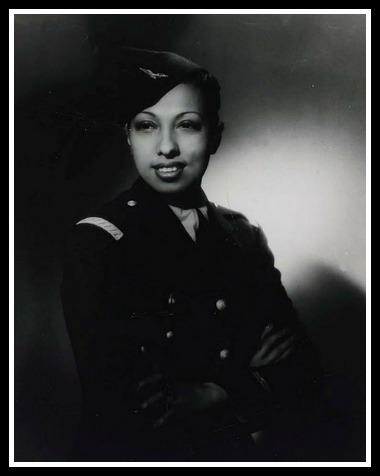
Josephine in uniform
As always we go into much more detail in the podcast but essentially her spy duties came to a halt when she was hospitalized in Casablanca for 19 months.
But that wasn’t the end of the war efforts of our heroine! Once recuperated, she went back on the road, this time helping to spread a message of brotherly love by entertaining racially integrated audiences of soldiers. Ultimately she received two prestigious awards for her work in the war, the Croix de Guerre and the Medal of Resistance. And by the end of the war, she entered her fourth marriage, to her band conductor- Jo Boullion.
The war ws over, but Josephine still has some fight in her. At this point in her life, she directed it toward the fight for racial equality. She not only had lofty goals she had big…no, massive plans.
First she and Jo remodeled an old castle she named Les Milandes, in the south of France, into a tourist destination with a theme of brotherly love. This pricey undertaking required some capital, so off she went on another world tour. This time she was confronted with more racial barriers and opportunities for her to use her celebrity. One, an incident in New York’s famous Stork Club that involved then popular newscaster, Walter Winchell, got her banned from reentering the US for many years. (It’s a doozie, and we gossip on about the details in the podcast)
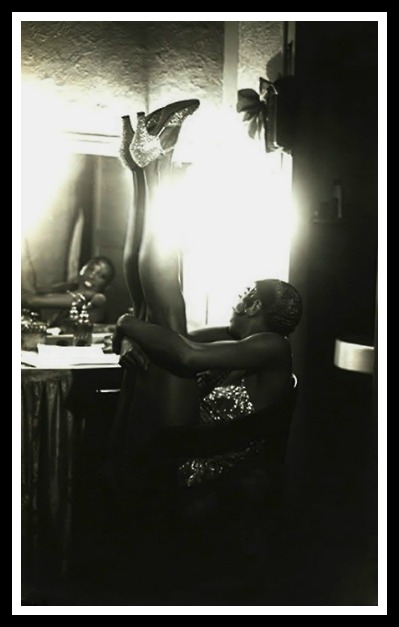
Next up, Josephine embarked on a plan to finally put herself in the role of a lifetime: Mother. She and Jo began to adopt babies of all colors and nationalities from around the world. They named the TWELVE children, The Rainbow Tribe.

Jo and Josephine with their young, and as yet incomplete, tribe
But it’s not all rainbows and sunshine for this unique family.
Act Four
(Open on Jo driving away from Les Milandes, Josephine and 12 stunned children left in his wake)
Josephine and Jo didn’t see eye-to-eye on many things. Ahem, many – but one important one being the children: How many? How to raise them? When was enough enough? When Josephine was on tour, the children were raised by Jo and a series of nannies at Les Milandes. Mama would breeze in, sometimes with a new brother or sister- take a few pictures, love on them all, then go back on the road. The costs of the constant renovations to the castle were astronomical, and eventually she was so far in debt she couldn’t get ahead. Jo couldn’t understand her, deal with her, take it- whatever his reasons, he left – although they never divorced.
On one hand she had this falling down resort that is getting her more and more in debt each day and is filled with her very large family.
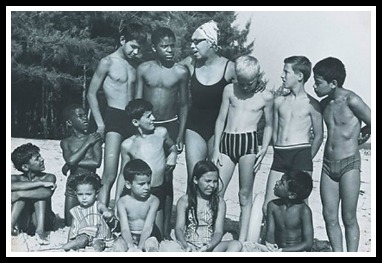
The tribe has grown and are growing up
On the other hand, she was doing civil rights work all over the world as she was touring . She even spoke with Martin Luther King, Jr at the March on Washington as the only official woman speaker.

Josephine at the March on Washington
So what hand won?

Josephine after being forced out of Les Milandes
Not Les Milandes. She got physically tossed out of it. But that’s again, not the end. Over the next few years, in not so short order: Princess Grace rescued her, helped set her up in a sweet villa in Monaco and funds a comeback show.
Opening night in Paris. It’s April, 1975 and Josephine is 68 years old. Does the old girl still have what it takes, or has Paris already seen the best she had to offer years before? Is she a washed up has-been, or a timeless superstar?
When the reviews came in the roaring cry was… Superstar!
Josephine was back on the stage, the cheers of the crowd ringing in her ears- she was a success.
The next day, no one could wake her as she lay among her rave reviews in the papers. She would never awake again. Within the week she was declared dead of a brain hemorrhage on April 12, 1975.

Josephine’s funeral procession through the streets of Paris
Fin
TIME TRAVEL WITH THE HISTORY CHICKS

You can visit Les Milandes without ever leaving your house! This is a really fun website and one of the few where we don’t mind music. Les Milandes Website.
If you are leaving your house and headed to New York, maybe you can dine at Chez Josephine, NYC.
Although her life really reads like a movie, this is the one movie that we could get our hands on: 1991 The Josephine Baker Story starring Lynn Whitfield.
We know you like your books and here are the ones that we recommend for this woman:
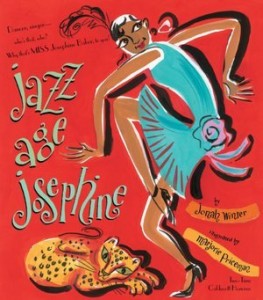
Children’s book: Jazz Age Josephine by Jonah Winter illustrated by Marjorie Priceman
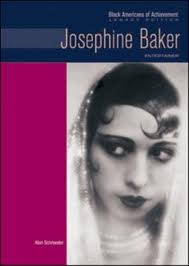
Middle Grade-Josephine Baker: Entertainer by Alan Schroeder
Have your own compare and contrast fest with these three biographies:

The Josephine Baker Story by Ean Wood
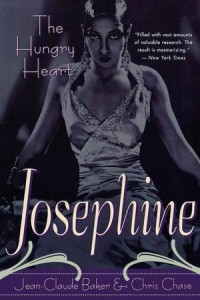
Josephine Baker: The Hungry Heart by Jean-Claude Baker and Chris Chase

Josephine by Josephine Baker and Jo Bouillion

Josephine Baker: Image and Icon by Olivia Gonzales
As always, our music comes courtesy of Music Alley. Visit them at Music.mevio.com
by The History Chicks | Jan 13, 2013 | Biography Episode, Episode, Podcasts, Shownotes
Josephine Baker is often remembered simply as the woman who danced wearing nothing but a skirt of bananas in Paris during the 1920’s. But her life was far from simple. She was not only a dancer and singer, but also a spy, a civil rights activist and a mother. She reinvented her life by sheer will and wits so many times that it’s not surprising that there are as many variations to her tale as there were roles in her life.
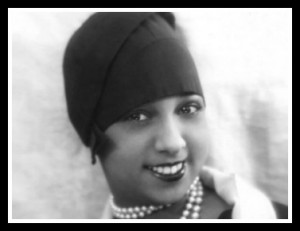
A young Josephine Baker
When we sat down to talk about this unique woman, we went a little long. Josephine wrote several auto-biographies- each painting a slightly different picture of her life. Several more biographies were written after her death- each giving slightly different details. Once we began our chat, we often ran into conflicting stories…it was so cool! Did she or didn’t she? Was she or wasn’t she? So many versions!
History rocks. It really does.
***And the story of Josephine’s life is also a little racy, parents may want to preview the podcast first it to decide if it’s age appropriate for their kids.***
We have divided our conversation into two parts, and the show notes into acts. She was different from anyone in her generation (although she reminded us of several woman since) it seems fitting that our coverage of her life should be a bit different as well.
ACT ONE: A CHILDHOOD OF POVERTY
(Open on a poor, urban neighborhood in 1906)
On June 3, in St. Louis, Missouri Freda Josephine McDonald was born to Carrie McDonald. Listed as her father on her birth certificate:”Edw”. Mysterious! The father of record is Eddie Carson, a drummer who Carrie had spent a great deal of time with. Eddie would deny his role in the life of the baby who her mother nicknamed, “Tumpy”. To deepen the paternal mystery- Carrie was very dark skinned, and Josephine was quite light. Even her birth had enough gaps to allow various tales to emerge. Hold on tight for the rest of her life!
We know this: She was born into poverty and lived in poverty for her entire childhood. Mama Carrie would pass Josephine back and forth between Grandmother Caroline and Aunt Elvira and Carrie’s home. As always we go into greater detail during the podcast, but Carrie soon married Arthur Martin and the couple would have three more children. Carrie worked as a laundress, Arthur worked at whatever he could whenever he could, but the family was never able to dig themselves out of poverty.
Josephine was sent to school, but she didn’t attend for long. Some times she was shipped off to work for families other times, as she got older, she would simply skip class. When she was ten, race relations is St. Louis heated up and resulted in a serious time of rioting.
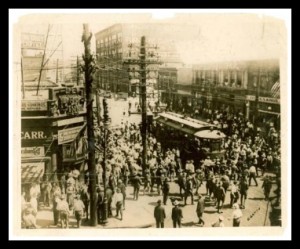
A trolley in East St. Louis is blocked by rioters in 1917
While East St. Louis burned during the riots, Josephine was safely on the OTHER side of the city. But the event most probably impacted her life, having such hatred and danger within walking distance would have to have been frightening.
At the age of 13, Josephine had her first marriage to Willie Wells, a steelworker. This didn’t last long, something about Josephine faking a pregnancy…or maybe being pregnant and having an abortion led to Willie leaving and never returning.
ACT TWO: BIRTH OF A SUPERSTAR
(Open on a young Josephine staring wistfully at an old, run down but still operational theater)
So maybe marriage wasn’t Josephine’s ticket out of her sad family life. She had been drawn to the theater, most specifically the Booker T. Washington Theater. There she would watch and imitate the acts, then take what she had learned outside to entertain patrons waiting for a show to begin. Eventually she worked her way into a dance troupe called, The Dixie Steppers.
With this troupe she would eventually go on the road, performing all over the south-eastern portion of the US and then heading north to Philadelphia, Pennsylvania.
By the time Josephine reached Philly she had begun to create the comedic moves and offstage persona that would take her far.
But first, she had to get married again. This time the man, Billy Baker, gave her a small moment of familial stability and the last name that she would use for the rest of her life.
While Josephine had been taking steps up the performance ladder she kept her eye on the next level. With a few fancy moves of her own, the untrained dancer earned a spot on the first all-black show that played on Broadway, Shuffle Along.
So long, Philly and so long Billy!
In New York, and traveling throughout the country with the road show, Josephine honed her craft to the best of her ability, although was probably a choreographers nightmare. She was not only an untrained dancer, but her style included rolling her eyes, making funny faces and breaking into the dances of the age. While the audiences loved her comedic antics, the rest of the cast wasn’t amused about being upstaged. Another challenge for her was the color of her skin. Too light for some chorus lines, too dark for others.
Josephine moved to other shows when Shuffle Along closed, and was a prominent figure in the Black Renaissance of Harlem during the early 1920’s. She watched other successful acts, added (read:stole) new material for hers and worked more on her off-stage diva persona. She would strut around the streets and in after-hours clubs in increasingly outlandish outfits making sure that she was seen by as many eyes as possible. She dated as many men as she could, and worked day and night to develop a wild and exotic image.
In modern vernacular- she was establishing her brand.
Through another series of situations where she saw an opportunity and clawed her way to it, 19 year-old Josephine was soon cast in a new show being produced by an American named Caroline Reagan who wanted to bring the flavor of the Black Renaissance and American Jazz…to Paris.
(Montage to show almost overnight success of rising American chorus girl to Superstar in Paris)

Josephine entertains Parisians with exotic American dances like The Charleston and other truly exotic routines
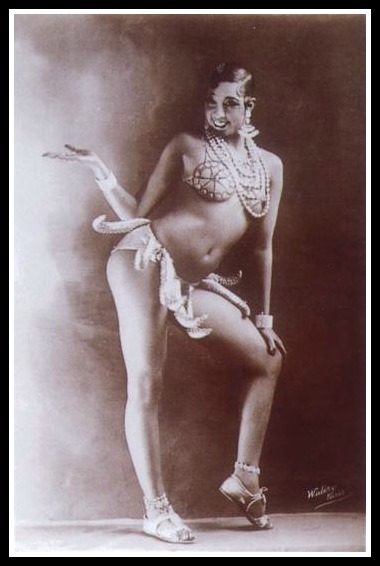
Josephine shows off the costume (plus a bikini top that she wouldn’t have been wearing on stage) for her famous Banana Dance

The set for her Banana Dance
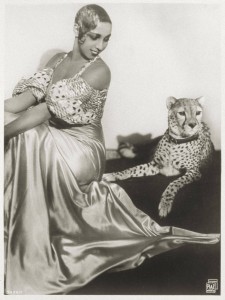
An almost overnight sensation, Josephine’s offstage and onstage personas melt into one bright, exotic superstar. Here with her pet cheetah, Chiquita
How did she climb so far, so fast in a country where she could barely speak the language? Partially because she was an exotic act to them from her first step on stage- they hadn’t seen anything like her and her charisma and antics won them over. Partially because she was willing to reinvent herself as audiences bored of her act. Partially because she was bold and brazen and very little frightened her. And partially because of a man she met early on in her days in France- “Count” Pepito de Abatino. Pepito was as much of a Count as Josephine was- that is to say, not at all. But when she paired up with him as her manager (and lover and fake husband) she began to soar. Paris couldn’t contain her so she toured all through Europe and South America causing both scandal and admiration as she did.
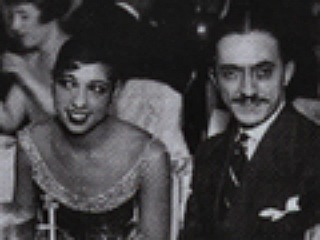
Josephine and Pepito, Paris circa 1927
Josephine was huge in a great portion of the world, but her native country had yet to embrace her. Ten years after Pepito took her career to a level she had never imagined, he took her someplace that she dreamed of taking like she had Europe. He got her a booking in America. Could Josephine become a superstar on her native soil? Would her own country shun or warmly welcome her arrival?
*INTERMISSION*
TIME TRAVEL WITH THE HISTORY CHICKS
We will post all of our book and media recommendations in Part Two, but thought you might like a select YouTube tour of Josephine’s life. All of the videos are PG -rated and will let you see her talent, her beauty and how she progressed through the years.
BANANA DANCE- Yes, we know- this is what you want to see and here is a version with a top on. Just watching this one video, we quickly saw what it was, that X factor that she possessed that drew people to see her. Lookit those bananas move!
From silent film 1927- This clip shows you her facial expressions and dance style- the moves that got her noticed even with no formal training.
Princess Tam Tam 1935– This is a short clip from one of her movies. She appears first at about 2:30, but the stage show is fun to watch.
Cha Cha circa 1950 – This is Josephine later in life, singing. She’s come a very long way (Baby) from the young banana dancer, don’t you think? Don’t Touch my Tomatos, and Cha Cha
Short interview with her later in life (SPOILER ALERT: This covers material in Part Two- it happened, you can read all about it, but we didn’t want to spoil it if you are waiting for us to tell you the story). This is in French. So you don’t speak french, so what? Just watch and hear her own voice talking in the language of her adopted country. She is watching Bridget Bardot speak on her behalf from her home in the early 1960’s.
As always, music comes courtesy of Music Alley. Visit them at Music.mevio.com
by The History Chicks | Nov 30, 2012 | Biography Episode, Episode, Podcasts
Part One of our discussion ended with the very deadly coronation events of Nicholas II and Alexandra. Russia was heading into a dire economic crisis and Nicholas stated that he intended to continue his reign in the same manner of his father, Alexander III. Will the new Tsar and Tsarina turn the country around? Will Nicholas lead his country to recovery? Will Alexandra ever get away from the meddling eyes of her Mother-in-law? Will she produce that male heir that is so necessary to the future of the Romanov dynasty?
It really does sound a little like a soap opera, doesn’t it? Sadly, the scenes that played out- while filled with glitz and drama like a movie- were very real.
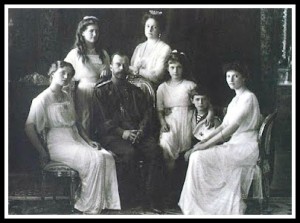
The family circa 1913
What Nicholas and Alexandra thought of as strong traditions, others viewed as old fashioned and not at all in touch with the needs of the people. Politics aside, the couple did have a very beautiful life and were very much in love. They settled in Tsarkoe Selo, creating as cozy a home as they could in a corner of a very large, very opulent palace. Their entire life was filled with extravagant homes, jewels, and living. (For more detailed information on the palaces, Faberge eggs, and other peeks into the lifestyle of this family and Russia during their reign, please see the shownotes for Part One of this series, or start at Alexanderpalace.org)

Oh, this little place? Home base- Tsarkoe Selo just outside of Saint Petersburg
The Tsar and Tsarina got busy building a family ever yearning for the male heir to carry on the family business, so to speak.
Grand Duchess Olga, the first born in 1895 was followed by Tatiana two years later. Two years after that, Maria and right-on- time-child number four- Anastasia. While all of the children were loved by there parents, and very much wanted- they were not the desired male child and Alex started to freak out just a little. As always we go into greater detail on the podcast, but she went to some extreme methods (and you know how much we love to talk extreme fertility methods) to conceive a son.
Finally, in 1904, Alexandra gave birth to Alexei,Tsarevich of Russia. The family was complete.
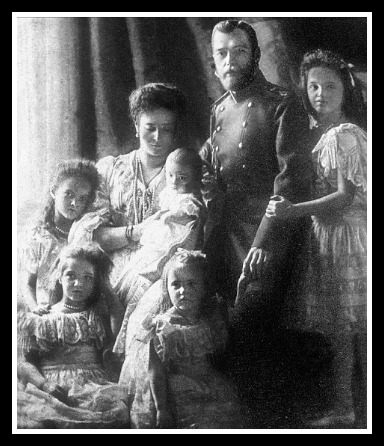
The family was finally complete
Unfortunately, Alexei’s mother passed down to her son a trait that she had inherited from her grandmother, Queen Victoria- hemophilia. Early in his life he was diagnosed, and Nicholas and Alexandra chose to keep his condition secret. Desperate for a cure from the painful and life threatening condition, Alexandra turned to a rather unorthodox measures, including befriending and entrusting the services of Grigori Rasputin- a sham sham mystic with questionable ethics. But it seemed as if he was able to help young Alexei’s bleeding, and for reasons that perplexed many Alexandra trusted him with her family and often called upon him for guidance and counsel. Rasputin’s unusual relationship with the family, as well as his scandalous lifestyle would draw harsh criticism from the Russian people. His violent murder the result of some thinking that he had undue, and misguided influence over the Imperial family. (Basically, he didn’t play well with everyone)
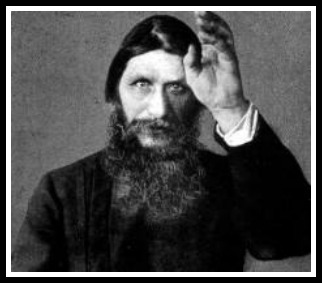
Stranger Danger... Grigori Rasputin
As the children grew, Alexei’s condition caused Niki and Alex to protect him not only from injury, but to help protect the secret. The family became more withdrawn from society, cloistering themselves in their various residences. Educated at home with the best tutors, the girls adored their baby brother and were each other’s besties. The family traveled, from one palace to the next- creating a sort of annual migration between them all. While the family hobby of photography left us with an abundance of pictures, the family themselves participated in as few official functions as possible and spent most time with each other. We see far more of them now than their contemporaries did at the time.
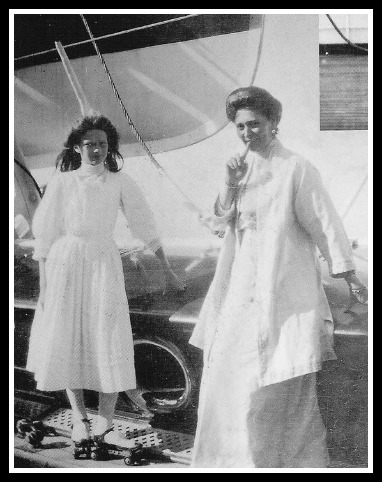
A rare smile on the face of Alexandra, with Olga rollerskating on the deck of The Standart
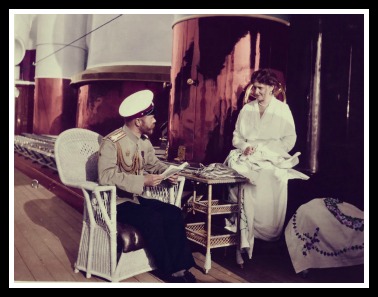
"Would you like eggs for breakfast, my Dear?" "Oh yes, but from a chicken, not a jeweler." *Insert regal laughter* Ok, made that up. But Niki and Alex being chill on the royal yacht
The idyllic and private life that the family created for themselves was not to last long. With the outbreak of , and Russia’s entrance into, World War I-Nicholas left for the front. Alexandra and the older two girls became nurses, and the younger two were given a small officers hospital to “oversee”. As war efforts go, they all were very hands-on participants, not afraid of a little blood and very attentive to those in their care.
Alexandra, however, didn’t do so well with Nicholas gone. And as World War I sort of morphed (overly simplified version, we know- we do go into more detail in the podcast) into a Revolutionary War- Nicholas’s absence from the family made her a little, well, nutty. To add to her Worry List, by 1917 serious plots were forming to overthrow the government. Revolts were getting organized and the people who supported the Tsar were becoming fewer and clashed with those who demanded change.
Eventually, Nicholas was asked to abdicate the throne- a position that he never had the training, skill, or temperament for but felt God had place him in. Thinking that he could walk away, sort of retire- Nicholas abdicated, not just for himself but also for his son, Alexei.
But a peaceful retirement was not in the future for this former Tsar. His family was put under house arrest at Tsarkoe Selo. As two different armies- White and Red- strengthened and jockeyed for power, the family was moved from their home to increasingly less opulent, then downright meager surroundings.

One of the last images of the Romanov sisters-Maria, Olga, Anastasia and Tatiana in captivity at Tsarskoe Selo in 1917
On July 17th, 1918 as Vladimir Lenin was gaining power, his Red (Bolshevik) Army battled the White Army that was still in support of the Tsar.The only way to guarantee a victory was to not have the Tsar rise back into power. The only way to do that, was to execute Nicholas.
Late at night, the family was awakened, told they would be moving again and to gather in a basement room. They did. And, in that room, the entire family was executed.
But the story doesn’t exactly stop here. The bodies were moved and hidden. With no bodies, the whereabouts of the family could not be determined. For many years people came forward claiming to be members of the Imperial Family, the most notable being Anna Anderson. All were found to be fraudulent.
All but two of the bodies were discovered in 1979- with confirmed identification not taking place until 1991. The final two, Alexei and Maria- were not found and the identities were not confirmed until 2007. (More detailed information about the last days, the house where the murders took place, as well as the discovery, exhumation and identification of the bodies can begin here, at Romanov-memorial.com)
TIME TRAVEL WITH THE HISTORY CHICKS
For other media recommendations, please see the shownotes for Part One of this series because we are about to go book-tastic all over this space.
This is by no means a fully inclusive list of books about these women, this family, this dynasty, this country- this is simply a list of the ones that we would recommend based on our research.
This is the book that Beckett specifically mentioned in the episode (and the title is one that we felt we were living while getting this two part episode to you.)

The Curse of the Romanovs, Straton Rabin
The rest are in alphabetical order based on book title…it was the only fair and orderly way we could think of.
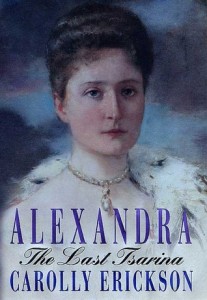
One of Beckett's Favorites:Alexandra: The Last Tsarina byCarolly Erickson

One of Susan's faves: A Lifelong Passion by Andrei Maylunas and Sergei Mironenko

Alix and Nicky: The Passion of the Last Tsar and Tsarina by Virginia Rounding
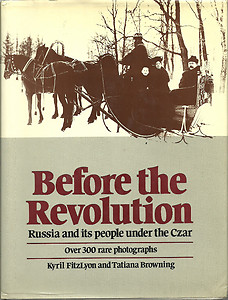
Before the Revolution by Kyril Fitzlyon

Chronicle of the Russian Tsars by David Warnes
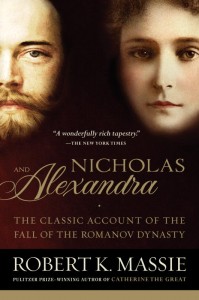
Nicholas and Alexandra by Robert Massie
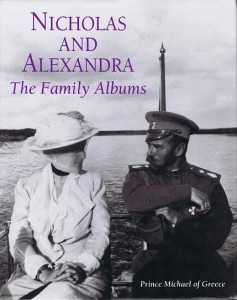
Nicholas and Alexandra: The Family Albums by Prince Michael of Greece

One of Beckett's Faves:The Court of the Last Tsar by Greg King
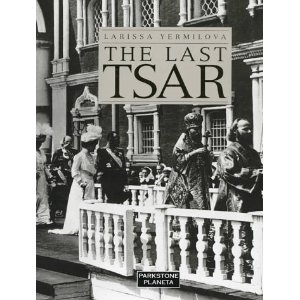
The Last Tsar by Larissa Yermilovna

One of Susan's Favorites: The Lost World of Nicholas and Alexandra by Peter Kurth
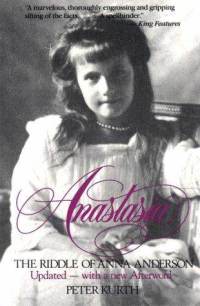
The Riddle of Anna Anderson by Peter Kurth
As always our music comes courtesty of Music Alley, visit them at music.mevio.com
by The History Chicks | Nov 11, 2012 | Biography Episode, Episode, Podcasts
Every season we let you choose a winner in our Guaranteed Content Poll. We grant that request and bring Season Three to a close with your winner- The Romanov Sisters. But, we decided to give you more than you asked for and expanded on the topic to include the entire family. What an epic subject! The story of the Romanovs begins in 1613, and doesn’t really end until 2007! More than one episode could handle, so we have broken it into two parts.

We'll chat about all of them...and more! Romanov family circa 1913
Part one begins with a Tiny Tiny Romanov Tutorial. We give a very brief history of the very long reign of this Imperial family. Beginning in 1613 when the 16 year-old nephew to Ivan the Terrible- Mikhail is crowned the first Tsar of Russia. Fast forward through time, past some Greats (and some not-so-greats) we finally land at Alexander III who we fondly call,”Papa Tsar”. He is the father of Nicholas and his death shortly after the engagement of his son to a well connected Princess begins the reign of the last Tsar, Nicholas II.
The Princess in this story was christened (deep breath) Princess Victoria Alix Helena Louise Beatrice of Hesse and by Rhine. Or Alix for short (and “Sunny” if you knew her really well).
Alix was the daughter of Alice, and Alice was the third child of Queen Victoria and Prince Albert. Not too shabby as royal lineage goes. Early in her life Alix lived up to her nickname and was sunny and happy. Then a diphtheria epidemic hit her home and Alix lost her little sister and her mother. Gan Gan Victoria did give Alix and her siblings a mother figure as often as she could while they grew up.
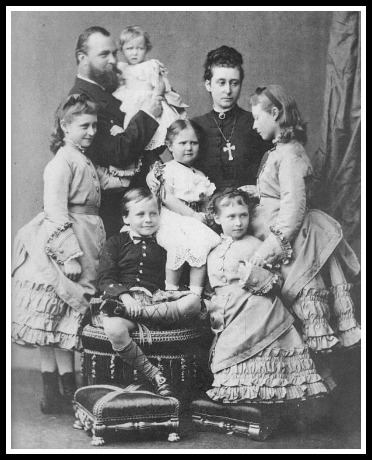
Alice and Louis and family, little Alix (in white) is leaning against her mother, looking concerned.
She also gave Alix something even less cheery and warm: Hemophilia- or rather the gene that carries it. Through her bloodline, Alix became a carrier for the bleeding disorder.
As always, we go into much more detail in the podcast, but life briefly became sunny again for her when she spent time with Nicholas. They met when he was 16, she merely 12 at Alix’s older sister Ella’s wedding. Both were smitten, however neither family was crazy about the match and tried to throw more politically adventagous suitors before both of them (as well as one that was merely designed to distract the young man). But the plots were unsuccessful and, after many years of exchanging letters, visits and flirtations, Nicholas proposed
Alix cried.
And not happy Yes! Yes! tears, either.
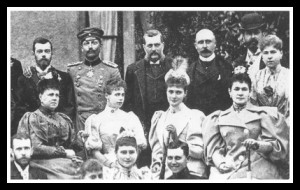
Taken at the wedding where they became engaged. Alex looking a little flirty (middle row, second from right) and Nicholas looking really uncomfortable in the arm of Cousin Willy (Kaiser Wilhelm)

And shortly afterward (note: same clothing), the happy (?) couple
She would have to leave not only her country, but also her Lutheran faith. To become part of the Imperial family, to become the next Tsarina she would have to convert to Russian Orthodoxy. After many tears, and questionably intended drama, she accepted.
Our couple would not have a leisurely engagement. Shortly after their betrothal was announced the rapidly failing health of Papa Tsar took a turn for the worse. Nicholas called Alex to be at his side as his father passed away. For more prepared future rulers, this would have been a time of sadness as well as a preparation to step up to the role that he had been trained for his whole life.
But that’s not exactly how Nicholas felt. In the shadow of his strong father, Nicholas had grown up lacking both the temperament to rule but also the training. But with his father’s death, he had to accept his role and duty to Russia.
Nicholas and Alexandra -as her name became- were wed.
Not only was Alex now in a new country with new customs and societal rules- she had some rather unique Mother-in-law issues.
Dowager Tsarina Maria was not only unwilling to give up the life she knew, it wasn’t required of her. She stood at her son’s side, as his wife walked paces behind them, continuing with her life as it had been before her husband had passed. To complicate the situation, the newlyweds had to live with her. The wedding was so rushed that no home had been set up for Nicholas and Alexandra.
Within a year the first child, Olga was born to the couple. They both loved being parents, but were also preparing for another life change: their coronation of the new Tsar and Tsarina of Russia. The religious ceremony would establish Nicholas as the head of the autocracy, and marry him to his country in what was thought of his God given position as ruler.

Crowds packed Moscow to witness the coronation of the new Tsar, with disastrous results.
This happy event brought out millions of spectators and, despite the falling economy of the country, no expense was spared. Parades and balls and pagentry galore- and all went well…until a stampede of spectators eager for ceremonial swag created a deadly situation. The exact number of people that were trampled to death us unclear, but up to 3,000 people died that day. How the people saw the reaction of their new ruler played a part in what will be the legacy of his rule.
Tune back in soon for Part Two of this sad story of the last Imperial Family of Russia.
TIME TRAVEL WITH THE HISTORY CHICKS
You want more Romanovs! We get that. We did, too. There is no shortage of images, websites and blogs of this Imperial Family online. We whittled down the list to our favorites and because this is a two-part subject, we are going to link you up with everything but books here. Check back for Part Two for all of our (many) book recommendations.
You want pictures and the stories behind them? You want to tour the palaces from the comfort of your home? You want to see all those jewel encrusted Easter eggs? Click on over to Alexander Palace Time Machine to get enough Romanov intel and images to keep you occupied for a very long time.
Another really great site that has videos and tons of biographies is Royal Russia- The Romanovs.
Finally, you might enjoy checking out NicholasandAlexandra.com
The podcast that we reference in Part Two, Russian Rulers History Podcast, can be found on your favorite podcast aggregator.
Movies! Although we end this part of our tale before Anastasia is even born, she is the subject of two films that were pretty good.

1956 Anastasia with Ingrid Bergman and Yul Brenner
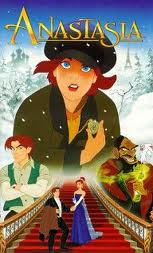
1997 Animated version starring voices of Meg Ryan and John Cusak
We talk about it these movies and links in Part Two(which will make this link make sense) but you might enjoy checking out the Animated Things Club podcast.
And because it’s funny, here is a link to part one of the Frasier episode, A Tsar is Born.
As always, music comes courtesy of Music Alley. Visit them at Music.mevio.com








































































